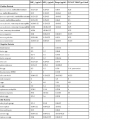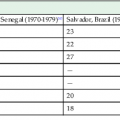Raphael Dolin
Antiviral Agents
General Principles
The development of antiviral drugs has historically lagged behind the development of drugs against other microbial agents. In part, this was because of difficulties in detection and study of many viruses and because of challenges in the evaluation of the effectiveness of chemotherapeutic and chemoprophylactic agents against viral infections. However, in recent years, the search for and evaluation of antiviral drugs has become increasingly active, fueled in large part by advances in understanding of molecular virology and viral pathogenesis and by the development of highly specific, sensitive, and quantitative methods for viral detection. More than 50 antiviral agents are now available to treat various viral infections, including 23 to treat human immunodeficiency virus (HIV) infections (see Chapter 130), and many additional agents are at various stages of preclinical and clinical development. The development of laboratory methods to guide administration and to assess efficacy of antiviral drugs has also historically lagged behind that of methods utilized to treat bacterial infections. However, led by antiviral therapy for HIV and hepatitis B and C virus infections, methods are now becoming widely available to assess sensitivity of viruses to antiviral drugs, to quantitate viruses in host compartments (virus load), and to determine pharmacokinetics of antiviral drugs. These now provide the framework for appropriate use of antiviral agents.
General principles for the use of antiviral agents are reviewed in this chapter. Specific antiviral agents are discussed in Chapters 44 through 47, and antiretroviral therapy is discussed in Chapter 130.
Activity of Antiviral Agents
The antiviral activity of agents against viral infections can be divided into two broad categories: (1) agents that directly inhibit viruses, usually at the cellular level (antiviral agents); or (2) agents that augment or modify host defenses to viral infection (immunomodulating agents).
Mechanisms of Action
The mechanisms of action of antiviral agents generally involve inhibition of a virus-specific step in viral replication. Because viral replication depends primarily on host cell metabolic functions, useful antiviral agents should inhibit virus-specific functions and leave host cell functions intact, or at least preferentially inhibit virus-directed as opposed to host cell–directed macromolecular synthesis. Consequently, antiviral agents typically have a restricted spectrum of activity. Although many compounds can be found that exhibit antiviral activity in vitro, most also affect some host cell function and are associated with low therapeutic ratios or may have unacceptable toxicity in humans. Most current antiviral agents inhibit ongoing viral replication, and replication may resume when the drug is removed. Thus, current antiviral agents are ineffective in elimination of nonreplicating or latent viruses.
Inhibition of Viral Nucleic Acid Synthesis
Many antiviral compounds are nucleoside or nucleotide analogues whose mechanism of action is inhibition of viral nucleic acid synthesis. Nucleoside analogues such as acyclovir and penciclovir require phosphorylation to the monophosphate, which requires a thymidine kinase coded by herpes simplex virus and not present in uninfected cells.1 Cellular kinases phosphorylate acyclovir to the triphosphate moiety, which inhibits the viral DNA polymerase and is incorporated into viral DNA as a chain terminator, thus inhibiting viral DNA synthesis. The requirement for a virus-encoded enzyme provides a virus-specific mechanism of action. Herpes simplex viruses that lack a thymidine kinase are resistant to acyclovir and penciclovir.2
Cidofovir is a monophosphorylated nucleotide analogue that does not require a virus-coded thymidine kinase for its activity. It utilizes cellular kinases to convert it to a diphosphate moiety that inhibits viral DNA polymerase and also causes premature chain termination. It is active against viruses that lack thymidine kinase and are therefore resistant to acyclovir and penciclovir.3
Foscarnet is not a nucleoside or nucleotide analogue but rather a pyrophosphate that blocks the pyrophosphate-binding site on the viral DNA polymerase. Thus, it does not require intracellular metabolism for its anti-herpesvirus activity.4
A novel mechanism of action, inhibition of the helicase-primase complex is manifested by amenamevir5 and pritelivir,6 which are active against herpes simplex viruses types 1 and 2. The helicase-primase complex is a heterotrimer consisting of helicase, primase, and cofactor subunits that are essential for DNA replication. Amenamevir and pritelivir are not nucleoside analogues, do not require phosphorylation by thymidine kinase, and are therefore active against viruses that are resistant to acyclovir and penciclovir because of thymidine kinase deficiencies. Amenamevir and pritelivir are undergoing clinical studies in suppression and treatment of genital herpes (see Chapter 45).
Letermovir is an antiviral agent with activity against cytomegalovirus through inhibition of the viral terminase enzyme complex, which results in interference with processing and blockage of viral DNA.7 It does not inhibit the viral DNA polymerase and is therefore active against cytomegalovirus strains resistant to ganciclovir, cidofovir, and foscarnet.
In HIV infection, nucleoside and nucleotide analogues inhibit viral complementary DNA synthesis through inhibition of reverse transcriptase. These drugs must be phosphorylated to the triphosphate moieties for anti-HIV activity. They include zidovudine, tenofovir, emtricitabine, and abacavir. Non-nucleoside reverse-transcriptase inhibitors (NNRTIs) also bind to reverse transcriptase but do so in a pocket far from the active site, in contrast to the nucleoside and nucleotide analogues. NNRTIs include nevirapine and efavirenz.
RNA Antisense Nucleotides
Antisense nucleotides inhibit transcription of messenger (m)RNA and can be utilized to inhibit replication of viruses. Fomivirsen is an antisense oligonucleotide that is complementary to a sequence in mRNA transcripts of the major immediate-early region 2 of cytomegalovirus.8 It is administered intravitreally to treat cytomegaloviral retinitis in HIV-infected patients who have failed or are intolerant to other treatments. Because of its unique antiviral mechanism of action, fomivirsen is active against cytomegaloviral strains that are resistant to ganciclovir, foscarnet, or cidofovir.
Viral Entry Inhibition
Inhibition of attachment of virus to its cellular reception or viral entry is an important mechanism for antiviral activity. Maraviroc is an allosteric inhibitor that interferes with attachment of HIV type 1 (HIV-1) to the CCR5 cellular chemokine receptor. Enfuvirtide is a synthetic peptide that inhibits gp41-mediated fusion of HIV-1 with the cell membrane and thus blocks virus entry (see Chapter 130).
Protease Inhibition
Many viruses require proteolytic cleavage of polypeptide precursors to activate essential viral proteins. For HIV-1, there are 10 clinically utilized inhibitors of such protease activity, which are important components of combination antiretroviral regimens. These protease inhibitors include ritonavir, nelfinavir, and atazanavir.
Boceprevir9 and telaprevir10 are peptidomimetics that inhibit the NS3/4A protease of hepatitis C virus by forming reversible covalent bonds with the NS3 active site. Multiple additional protease inhibitors against hepatitis C virus are under clinical development.
Integrase Inhibition
Integrase is an enzymatic activity required for integration of the HIV-1 genome into the genome of host cells, thus maintaining stability of the viral genome in the host. This function is inhibited by raltegravir and represents a relatively new category of antiviral activity (see Chapter 130).
Inhibition of Uncoating of Virus
The adamantane compounds amantadine11 and rimantadine12 interfere with the function of the M2 protein of influenza A virus and inhibit uncoating of influenza virus shortly after entry of virus into cells.11,12 Single amino acid changes can render viruses resistant to the adamantanes, as is the case with currently circulating (2013-2014) influenza A viruses.13
Inhibition of Virus Release
The neuraminidase inhibitors oseltamivir and zanamivir interfere with release of influenza A and B from infected cells.14,15 Neuraminidase prevents the clumping of released virus, and thus inhibition of this enzyme retards the cell-to-cell movement of virus.
Stay updated, free articles. Join our Telegram channel

Full access? Get Clinical Tree








